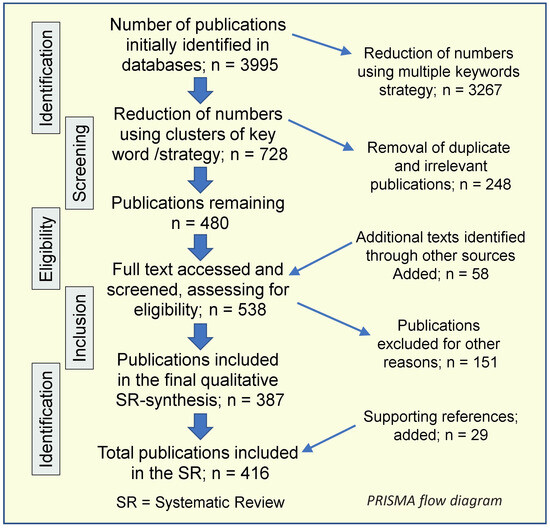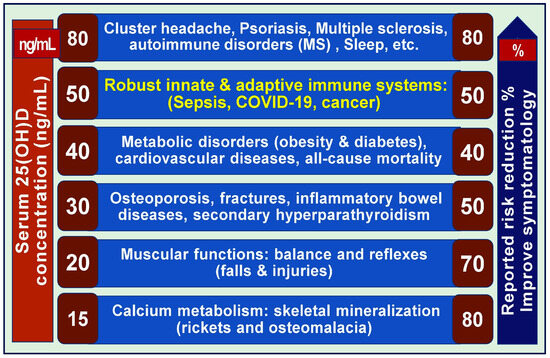Vitamin D’s Impact on Cancer Incidence and Mortality: A Systematic Review – by Sunil J. Wimalawansa
Source : mdpi.com
Abstract
Background/Objectives: Adequate vitamin D levels are essential for various physiological functions, including cell growth, immune modulation, metabolic regulation, DNA repair, and overall health span. Despite its proven cost-effectiveness, widespread deficiency persists due to inadequate supplementation and limited sunlight exposure. Methods: This systematic review (SR) examines the relationship between vitamin D and the reduction of cancer risk and mortality, and the mechanisms involved in cancer prevention. This SR followed the PRISMA and PICOS guidelines and synthesized evidence from relevant studies. Results: Beyond genomic actions via calcitriol [1,25(OH)2D]-receptor interactions, vitamin D exerts cancer-protective effects through mitigating inflammation, autocrine, paracrine, and membrane signaling. The findings reveal a strong inverse relationship between serum 25(OH)D levels and the incidence, metastasis, and mortality of several cancer types, including colon, gastric, rectal, breast, endometrial, bladder, esophageal, gallbladder, ovarian, pancreatic, renal, vulvar cancers, and both Hodgkin’s and non-Hodgkin’s lymphomas. While 25(OH)D levels of around 20 ng/mL suffice for musculoskeletal health, maintaining levels above 40 ng/mL (100 nmol/L: range, 40–80 ng/mL) significantly lowers cancer risks and mortality. Conclusions: While many observational studies support vitamin D’s protective role in incidents and deaths from cancer, some recent mega-RCTs have failed to demonstrate this. The latter is primarily due to critical study design flaws, like recruiting vitamin D sufficient subjects, inadequate dosing, short durations, and biased designs in nutrient supplementation studies. Consequently, conclusions from these cannot be relied upon. Well-designed, adequately powered clinical trials using appropriate methodologies, sufficient vitamin D3 doses, and extended durations consistently demonstrate that proper supplementation significantly reduces cancer risk and markedly lowers cancer mortality.
25(OH)D; 1,25(OH)2D; epidemiology; malignancy; metastasis; micronutrients; prevention; public health; health risks; susceptibility
1. Introduction
1.1. Systemic Challenges and Clinical Trial Designs Using Vitamin D
1.2. The Importance of Adjusting for Confounders in Clinical Research
1.3. Vitamin D—Cancer Risk Reduction vs. Mortality
1.4. Systematic Review Process
1.4.1. Literature Search
1.4.2. Rationale for the Study
1.4.3. Objective of the Study
1.4.4. Search Strategy
1.4.5. Protocol and Manuscript Selection

1.4.6. Data Abstraction and Synthesis
1.4.7. Literature Search and Analytical Outcomes
1.4.8. Scope of This Review and Outcomes
2. Vitamin D Requirements—Sun Exposure, Biological Functions, and Cancer
- I.
-
Not obese (average wt.: BMI, <29): 70–90 IU/kg BW
- II.
-
Moderately obese (BMI, 30–39): 100–130 IU/kg BW
- III.
-
Morbid obesity (BMI, over 40): 140–180 IU/kg BW
2.1. Sun Exposure and Generation of Vitamin D
2.2. Causal Role of Vitamin D Deficiency in the Development of Select Cancers
2.3. Vitamin D Plus Calcium—Effect on Cancer
2.4. Vitamin D 1,25(OH)2D Interactions and Cell Proliferation
2.5. Effects of Vitamin D on Cell Proliferation and Metastasis
2.6. Vitamin D Sufficiency–Protective Against Cancer
2.7. Effectiveness of Vitamin D in Different Cancer Types

2.8. Ultraviolet B, Vitamin D, and Prevalence of Cancer
2.9. Sun Exposure, Genetics, and Skin Cancer
2.10. Sun Exposure Reduces Cancer Risks
2.11. Additional Mechanisms of Vitamin D in Cancer Risk Reduction
3. Cancer Mortality Relationships
3.1. Major Challenges Associated with Nutrient Clinical Trials
3.2. The Factors Hindering Large Vitamin D RCTs from Generating Meaningful Data
3.3. Negative RCTs Do Not Mean That the Nutrient Is Not Efficacious
3.4. Rethinking Research Methods: Limitations of RCTs in Micronutrient Evaluation
4. Broader Outcomes from Vitamin D Clinical Studies
4.1. Effects of Vitamin D on Preventing Specific Cancer Types
4.2. Miscellaneous Cancers
4.3. Epidemiological and Meta-Analysis Data
4.4. Correlations of Serum 25(OH)D Levels with Cancer Incidence
4.5. Melanoma and Insulin-like Growth Factor
4.6. Prostate Cancer Risks and a J or U-Shape Curve
4.7. Prevention of Cancer Risk Reduction

4.8. Clinical Trials on Cancer Prevention
5. Improving Clinical Outcomes
5.1. Varying 25(OH)D Levels Required for Preventing Different Diseases

5.2. The Role of Vitamin D-Binding—Protein in Cancer
5.3. Adverse Effects of Vitamin
6. Discussion
7. Conclusions
Supplementary Materials
Funding
Acknowledgments
Conflicts of Interest
Abbreviations
| 1,25(OH)2D | 1,25-dihydroxyvitamin D |
| 25(OH)D | 25-hydroxy vitamin D |
| BMI | Body mass index |
| CKD | Chronic kidney disease |
| CVD | Cardiovascular disease |
| IU | International unit |
| kg BW | Kilogram, body weight |
| RCTs | Randomized controlled clinical trials |
| T2D | Type 2 diabetes mellitus |
| UV | Ultraviolet |
| VDR | Vitamin D receptor |




















